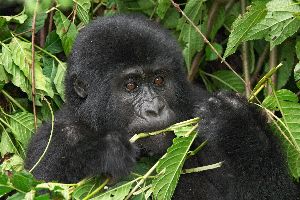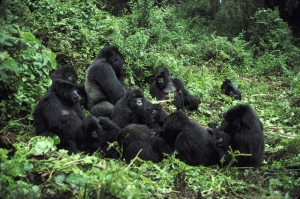David Attenborough’s “fresh push” to protect Rwanda’s endangered Mountain Gorillas
The moment capturing Mountain Gorillas curiosity in David Attenborough is a lasting memory for many and remains one of the most emotive wildlife films ever made. He was deeply moved and it was clearly a life-shifting experience for the naturalist and broadcaster.
David Attenborough has just voiced a 15-minute documentary on the conservation efforts of Mountain Gorillas by the charity that continues the work of Dian Fossey, the primatologist widely known by the film adaptation of her book, Gorillas in the Mist.

Fewer than 300 Mountain Gorillas remained when Fossey worked in the Volcans National Park in 1967, and although numbers rose to 480 in a 2010 census, the species is still listed as critically endangered by the authoritative IUCN Red List.
In Attenborough’s film, which was launched last week, he acknowledges the difficulties of working in a part of the world that has been beset by violence and unrest.
“The survival of the Mountain Gorilla and safety of its habitat is intertwined with the growth of a country in recovery since the Rwanda genocide of 1994”. He continues “Virunga rainforest extends across the border to eastern Congo. This border region is still plagued by violence, because of Rwanda’s genocide and the second Congo war.”
Attenborough also pays tribute to Fossey, who was murdered in 1985, a few weeks before her 54th birthday. The killer has never been identified. “Fossey made many enemies in her fight to protect the mountain gorillas. She ended up paying with her life ” Attenborough says.
The only remaining populations of Mountain Gorillas are in Rwanda, Uganda and Democratic Republic of Congo. The Rwandan group is the only population of apes whose numbers are increasing.
“Dian Fossey knew that the survival of the Mountain Gorilla depended on the education and progress of communities around them,” Attenborough says in his film. “Today in this densely populated country, communities still live and farm right up to he edges of the gorillas’ habitat. Children here are positive about their future, passionate about their environment, and full of love for the gorillas their people once slayed for their own survival.”
Clare Richardson, president and chief  executive officer of The Dian Fossey Gorilla Fund International, said: “We are all too aware that the survival of the Mountain Gorilla, and the safety of its habitat, is intertwined with the growth of a country in recovery since the atrocities of the Rwandan genocide of 1994. The work we do is unique, challenging and costly but we are seeing results. The population has grown and while this is encouraging, the mountain gorilla is still critically endangered and without extreme conservation work could face extinction.”
executive officer of The Dian Fossey Gorilla Fund International, said: “We are all too aware that the survival of the Mountain Gorilla, and the safety of its habitat, is intertwined with the growth of a country in recovery since the atrocities of the Rwandan genocide of 1994. The work we do is unique, challenging and costly but we are seeing results. The population has grown and while this is encouraging, the mountain gorilla is still critically endangered and without extreme conservation work could face extinction.”
Mountain Gorilla Facts
|
Name: |
Gorilla beringei beringei |
|
Number Remaining: |
Fewer than 800 |
|
Where they live: |
Uganda, Rwanda and the Democratic Republic of the Congo |
|
Characteristics: |
Mountain gorillas live in the misty mountain forests of hte Virunga Massif and Bwindi Impenetrable Forest in central Africa. They have longer, thicker fur than other gorilla subspecies, enabling them to live in colder temperatures. Adult males can weigh up to 200kg (31st 9lb), and are roughly twice the size of adult females. When they reach maturity (at around 12 or 13 years old), males develop the characteristic silver fur on their back that gives them the name ‘silverback’. Like all gorillas, mountain gorillas are very sociable and live in family groups led by the dominant silverback. They are largely herbivorous and eat a variety of shoots, fruit and leaves. |
|
Status: |
|
|
Population: |
Bwindi Impenetrable Forest and Mgahinga National Park, Uganda; Volcanoes National Park, Rwanda; Virunga National Park, DRC |
|
Main Threats: |
Habitat loss, poaching, civil unrest, disease |
Today, the Mountain Gorilla continues to be threatened. Professional naturalist, Stephen Mills has worked with David Attenborough on many wildlife films and is returning to the Volcanoes National Park and Bwindi Impenetrable Forest in Rwanda and Uganda, to observe the behaviour and social dynamics of 4 habituated gorilla groups that he last visited 8 years ago. He is inviting just 6 – 8 guests to join him and to have your own ‘Attenborough encounter’ with a mighty Silverback and inquisitive juvenile Mountain Gorillas. View the details of Stephen Mills’ Gorilla Tracking Expedition.

